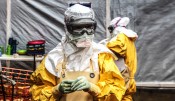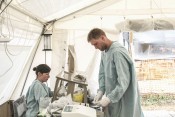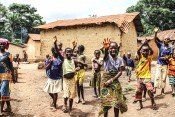|
Medicine&Health
 >
Ebola outbreak in West Africa
>
Ebola outbreak in West Africa
Ebola outbreak in West AfricaA mysterious feverIn early March this year, deep in the forest region of southeast Guinea, cases started to accumulate for a mysterious fever that claimed many lives among its sufferers. Muscle pain, high fever, vomiting and severe diarrhoea – all symptoms that doctors often observe in Africa's hospitals, but this time, all attempts to treat them proved futile.
Fig. 1: Doctors and care workers can enter the isolation ward only with appropriate protective clothing. For medical personnel, the work is extremely exhausting and stressful, both physically and mentally. With temperatures outside exceeding 30°C, focused work in the plastic protective suit with mouth guard, goggles and gloves is possible for only about an hour at a time. Children in isolation wards in particular are fearful of the masked helpers; the protective clothing makes communication with patients difficult.
Initially, patients were thought to be suffering from a severe form of malaria, which occurs throughout the year in this region. Accordingly, the local people went about the business of caring for their sick relatives and burying their dead as normal. Medical personnel from the NGO Doctors Without Borders, who had been providing support to a regional malaria project for a number of years, soon realised that this was not a typical malaria outbreak, however. The disease spread much too quickly, and whole family groups were falling ill almost simultaneously. On some occasions, patients from bodily orifices and died only a few days after falling ill. Doctors Without Borders alerted the Ministry of Health in the capital city of Conakry and the World Health Organisation (WHO). Epidemiologists were sent to the affected regions. By mid-March, the facts were clear: virologists from Lyon and Hamburg confirmed the outbreak as the first occurrence of Ebola fever in West African Guinea. This was the official starting-point of what has been the largest and most complex Ebola epidemic to date. Previous Ebola outbreaks had been reported only in Central African countries. Over the last 38 years, repeated outbreaks were reported in the Democratic Republic of the Congo (formerly Zaire), South Sudan, Uganda and Gabon. The Ebola virus takes its name from a tributary of the Congo River. It was along this river that the first documented Ebola outbreak occurred in 1976: a total of 318 people from 55 villages fell ill, of which 280 died – equating to a fatality rate of 88%. The first case occurred in a Belgian missionary hospital. Shortly afterwards, almost all of the nuns and nurses had fallen ill, as well as most of the hospital's patients. The sisters possessed just five hypodermic needles, which they had used for hundreds of patients – without sterilising them after each use.
Fig. 2: Electron micrograph of an Ebola virus. In this colourised EM image of a Guinea isolate, the characteristic thread-like structure of the Ebola virus can be seen (image used with the kind permission of Dr L. Kolesnikova, University of Marburg)
From reservoir host to humans Ebola viruses are zoonotic viruses. The natural reservoir for Ebola is thought to be various species of fruit bat. While the bats do not themselves fall ill, they excrete large quantities of the virus in their saliva and excrement. Normally, ebola viruses circulate unnoticed within the fruit bat population. Animals such as apes or forest antelopes can also become carriers as a result of their eating habits, however, if they pick up fruit partly eaten by fruit bats and infect themselves with the virus. Interestingly, the fruit bats are not only to be found in Central African regions. Their range also stretches as far as Western Africa. Every year, millions of fruit bats fly several thousand kilometres, chasing the rainy season, since the bounty of fruit to forage for is especially great at this time. While it is still unclear how Ebola came to be present in western Africa, it is logical to assume that fruit bats from Central Africa brought the Ebola virus to West Africa as part of their migrations. Transmission of Ebola viruses to humans is a relatively rare occurrence. In such cases, the infection occurs during the preparation and consumption of contaminated bushmeat – such as that from fruit bats or infected apes. As regards the current outbreak, it is assumed that the index case was an infant who probably caught the infection from a fruit bat and then proceeded to pass the infection on to family members. The spread and person-to-person transmission of the Ebola virus is achieved by direct contact with infectious bodily fluids, such as while caring for sick individuals or performing traditional burial rites.
Fig. 3: Patient blood samples are tested for Ebola virus in the EMLab in West Africa. Stationed in Guinea, the tent lab is staffed by experts from all over Europe.
Fig. 4: All of the equipment, chemicals and consumables required for diagnostics in the laboratory are packed into plastic crates. The EMLab project (http:/
Response of the human body to an Ebola infection The incubation period of an Ebola infection ranges from 2 to 21 days. People fall ill suddenly and the body first responds by exhibiting non-specific 'flu-like symptoms such as fever, headache and muscle pain, followed by nausea with vomiting and severe diarrhoea. When the virus enters the body, it first infects immune cells such as dendritic cells, macrophages and monocytes: this enables the virus to spread rapidly throughout the organism. This primarily affects vital organs such as the liver, spleen, lungs and kidneys; these suffer from necrosis and organ failure. The massive secretion of pro-inflammatory cytokines also causes endothelial permeability while disrupting blood clotting processes. As a result of the blood loss observed in a proportion of the patients, the Ebola virus is also termed a hemorrhagic fever virus. If disease progression is severe, the infection typically causes the patient to die from shock and multiple organ failure within 14 days after the first symptoms appear. Currently, there is no specific treatment option available. The symptom-oriented measures are merely supportive in nature and consist of the administration of infusions against fluid loss, pain relievers and antibiotics, so as to prevent possible secondary infections. The poor adaptation of humans to this virus of animal origin, combined with the lack of availability of a licensed and properly tested form of therapy, means that almost 70% of patients with Ebola are dying in the current outbreak in West Africa. Three major factors are responsible for continuous propagation of Ebola in West Africa Despite all of the efforts by the international community, the outbreak has yet to be brought under control. Currently, there are three primary factors that are promoting the spread of Ebola within the affected countries. The first is the transmission of Ebola in heavily populated urban areas in the capital cities of Conakry (Guinea), Monrovia (Liberia) and Freetown (Sierra Leone). Many of those who fall ill migrate to the capital in hope of receiving better healthcare, thus introducing the Ebola virus into the city. Attempts to break the Ebola epidemic's chains of infection in major urban areas with populations of several million people constitute a major challenge for the local health authorities and international aid organisations. Due to limited facilities in terms of beds and personnel, large numbers of patients can no longer be accepted at treatment centres. The second factor is the transmission of Ebola in rural areas. Many Ebola patients continue to be cared for by family members, although strict isolation and quarantine protocols must be observed to prevent the virus spreading further. Many people also contract Ebola from funeral ceremonies. In accordance with local customs, the corpse is washed and touched during burial in a rite of farewell. Since the viral load of the deceased is extremely high and any virus on the dead person's skin remains infectious for some time, many people become infected at funerals. The third factor driving widespread propagation is the cross-border transmission of Ebola into the frontier areas of Guinea, Liberia and Sierra Leone. Restrictions on travel, intended to keep populations within their own state boundaries so as to counter the spread of Ebola, are essentially unenforceable within this tri-border area. Trade and social interaction are two reasons for frequent and unverifiable border crossings. Since many people travel to visit their sick relatives or attend funeral services across the border, this makes patients and their contacts extremely difficult to pin down. Reasons for the scale of the current outbreak How did the virus manage to spread from a few dozen infected individuals to affect some 7,157 people (official WHO figure as on 1 Oct 2014)? A number of specific cultural factors have been decisive in promoting the spread of the disease. Many people become infected during traditional burial ceremonies: the customs of washing the dead before burial and touching them in a rite of farewell are particularly problematic. Nor is there universal acceptance within the various populations that Ebola hemorrhagic fever is really an illness and not some sort of magic curse. Local people also harbour a strong distrust of Western medical personnel. There have been occasional attacks on vehicles and personnel operated by national or international aid agencies. Rumours and myths, which spread like wildfire, work to further fuel peoples' anxieties, with the result that many refuse medical help after falling ill. Shortly after the outbreak started, for example, one rumour was circulating that white doctors had spread the disease to tempt people into treatment centres, where their organs would be harvested for use in wealthy countries. The fact that the dead are returned to their relatives only in sealed body bags or caskets adds weight to this hypothesis, causing families to doubt whether they are really receiving their loved ones back for burial. As a consequence, families then hide away their sick relatives – and small children in particular – which in turn leads to further cases of Ebola and deaths within the family. Another factor promoting the spread of the disease is the poor quality of the public healthcare systems in the affected areas. This Ebola outbreak is the first in West Africa. The countries were entirely unprepared for the outbreak and simply have no experience that tells them how health authorities should be handling this disease. No action plans for epidemics had been prepared and opportunities for the laboratory-based diagnosis of disease are extremely limited. The provision of basic medical care is virtually non-existent in the tri-border area of Guinea, Sierra Leone and Liberia in particular. Still affected by the legacy of the earlier civil war, this area lacks the medical infrastructure and trained personnel needed to stop the further spread of the Ebola epidemic.
In the field lab, work with infectious patient samples is conducted in a glovebox. Internal glovebox pressure is negative and intake/exhaust air is filtered to ensure no viruses can escape to the environment. Once the samples in the glovebox have been deactivated, isolation of the viral RNA and subsequent PCR-based diagnosis can be performed without any special safety precautions.
European experts join the fight against Ebola In Germany, laboratory diagnostics for a suspected case of Ebola must be performed in a biosafety level 4 containment lab. There are only two facilities of this kind in Germany: the Bernhard Nocht Institute for Tropical Medicine in Hamburg and Philipps University Marburg both operate this class of containment lab. These sites work with extremely dangerous viruses while observing very strict safety protocols. For protection, workers wear a totally encapsulating suit with its own air supply. If an outbreak occurs in a developing country such as Guinea, however, logistical problems prevent the shipping of samples to Europe for analysis in such specialist laboratories. Furthermore, a local diagnostic unit is also essential for making timely decisions about whether a patient is suffering from a severe form of malaria (for example) and not Ebola. This has important repercussions: if the patient has Ebola, s/he must be placed in quarantine; if s/he has malaria, however, then quarantine would risk exposing the patient to Ebola. To bring an outbreak under control quickly, a lab diagnostics facility at the epicentre of the outbreak is of prime importance. In 2011, a number of institutions from all over Europe – including the Marburg Institute of Virology – joined forces to establish the European Mobile Lab (EMLab) project. The aim of the project was to set up lab units for rapid deployment during the diagnosis of dangerous pathogenic organisms in Africa. Conceptually, the mobile laboratory project involved designing a way to pack a fully-functional laboratory into 12–15 transportable boxes. These boxes contain all of the technical equipment and lab materials necessary to perform molecular diagnostic experiments. This concept has the major benefit of enabling the entire set of equipment to be shipped using normal civilian air transport: the scientists can take the lab with them as their “luggage”. At the destination, only small vehicles are needed to transport the equipment. Once on-site, the laboratory can be operated using a local power supply running off car batteries or small generators. Shortly after the outbreak began, the WHO requested help from EMLab in the fight against Ebola. In late March, only a few days after the outbreak went public, the first EMLab team set up the mobile lab in the town of Guéckédou, in the forest region of Guinea's southeast. Direct collaboration between EMLab and Doctors Without Borders makes it possible to find out whether a patient is infected with Ebola in just four hours. The diagnostic procedure used here is real-time quantitative PCR. Over a period of six months, some 2,500 samples have now been tested for Ebola. European experts have been deployed in Guéckédou continuously since March, so as to perform diagnosis of suspected cases of Ebola. Five virologists from Marburg have also participated, in the form of multiple four-week foreign assignments in one of the European Mobile Lab projects funded by the European Union. Low risk of introduction to Germany All of the countries affected by Ebola operate international airports with direct flights to other countries in Africa, the Middle East or Europe. In early October, the Atlanta-based CDC public health agency confirmed the first case of Ebola imported into the United States. The man in question boarded a plane in Liberia without symptoms before falling ill a few days after arriving in the USA. The patient's travel history meant that the illness was identified quickly, with the introduction of quarantine measures and the identification of possible contact persons being completed without delay.
The likelihood of the disease spreading via air travel can be calculated statistically for each international airport around the world (http:/
National and international aid workers do not receive such a hearty welcome in every village. In some areas, anxieties, rumours and ignorance fuel aggressive tendencies that sometimes give rise to violent attacks: only a few weeks ago, the inhabitants of a village in Guinea ambushed members of a reconnaissance team, ultimately killing several of them.
The isolation ward in Guéckédou in Guinea's forested region has been run since March by Doctors Without Borders (Médecins sans Frontières). The large number of patients and the widespread propagation of the outbreak has pushed national and international aid agencies to their limits – additional support is now urgently needed.
Far-reaching consequences of the outbreak The end of the current Ebola outbreak is very difficult to predict. Cautious estimates published by the WHO assume that the epidemic could be brought under control by mid-2015. The further progression of the epidemic depends on a large number of factors. Direct action must be taken without delay. Medical personnel, logistics staff and more field hospitals must be transported to Africa, alongside large quantities of protective clothing. This is possible only with the concentrated effort of many countries. Financial aid alone is not sufficient. International attention and the recognition that a humanitarian crisis is currently occurs in West Africa – and one which could destabilise the entire region – have come very late. In affected regions, attempts at translation work must be redoubled, so as to integrate the concept of infectious diseases into the local inhabitants' cultural background. Effective interventions to protect against infection must be established that are compatible with day-to-day life. Local aid workers not only have to deal with a lack of acceptance from the population but also face severe physical and psychological challenges; they are often overwhelmed by the workload and the dire nature of the outbreak. To alleviate this situation, greater numbers of trained personnel are required. Drugs for treating Ebola – as were deployed to treat medical personnel flown out of the country – are likely to remain unavailable to sick individuals in West Africa for the foreseeable future, since they can be manufactured only in small quantities at this time. The World Health Organisation is now eagerly awaiting the results from two ongoing vaccination trials. These studies are designed to confirm both immunogenesis and harmlessness for a vaccine that has previously not been tested in humans. In the best-case scenario, several thousand doses of the vaccine could be made available to the West African population in 2015, stopping Ebola from spreading further. Seven months have passed since the low-profile start to this outbreak. Since then, more than 7,000 people have contracted the virus, with well over half of all patients ultimately succumbing to their infection. Initially affecting a handful of villages in the forested region of eastern Guinea far from the capital city of Conakry, the outbreak has since spread to the West African countries of Liberia and Sierra Leone, with cases also being reported in Africa's most populous country, Nigeria, as well as Senegal. The WHO expects to see about 20,000 cases by the end of 2014. Ebola is no longer a health problem that is limited to isolated countries: it threatens to destabilise West Africa. The global community must now mobilise all of its available resources, so as to finally bring the worst Ebola outbreak in history under control. Pictures: Thomas Strecker |
L&M int. 4 / 2014
Free download here: download here The Authors:Read more articles online |
























